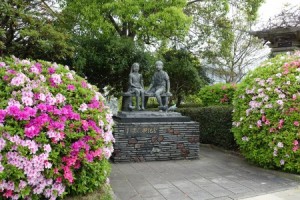
Some destinations, despite their previous history, are linked with a major historical event. Nagasaki, Japan will always be remembered as the second city after Hiroshima to be destroyed by an atomic bomb. Events that took place prior to August 9, 1945 will never rival what happened in the aftermath. After receiving the final Northeast Asian cruise itinerary, I planned on visiting Nagasaki’s main attractions- the Atomic Bomb Museum, the Atomic Bomb Hypocenter, and the nearby Peace Park.
All are conveniently located to the Port of Nagasaki. An organized, overpriced shore excursion is not necessary unless one is unwilling to take the tram/streetcar or a taxi. Tram tickets are sold in the terminal and aboard the vehicle. While the traveling distance is only a couple of miles, it is best to maximize your time by taking public or private transportation. Remember to pick up the Nagasaki Port Cruise Ship Welcoming Committee Map in the terminal. When we arrived, the map was being distributed to anyone exiting the ship.
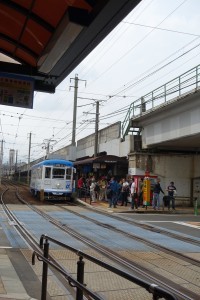
It should be noted that many cruise passengers thought that the city bus was the tram. The tram is powered by overhead electrical lines and is located in the middle of the road while the bus is a regular road vehicle that stops along the sidewalk. The streetcar is shortly after the bus stop. It should take less than 5 minutes to find the tram from the terminal.
At the 48-Ourakaigan Dori stop stand on the platform and wait for the No. 5 streetcar (Green Line) bound for Hotaraujaya. Get off at the second stop 31-Tsuki-Machi. If you did not purchase an all-day pass, ask the driver for a transfer ticket. Don’t forget to move to the other side of the platform and take the No. 1 streetcar (Blue Line) bound for Akasako. For the Peace Park area get off at 19- Matsuyama-Machi.
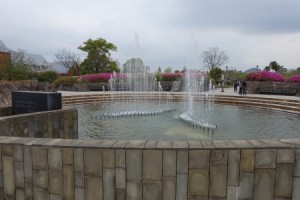
It was a very short walk from the tram station to the Peace Park. Signs are visible if you look. Upon entering the park, I was enticed by the overwhelming fragrance of the blooming flowers. An oversize round fountain was straight ahead.
The Fountain of Peace was originally constructed in 1969 and later reconstructed in 1985. Nagasaki City and the National Council for World Peace and Abolition of Nuclear Weapons designed this structure with the intent of reminding future generations of the people who died as a result of the atomic bomb. The fountain is seen as an offering of water to the victims of the atomic bomb and a prayer for the repose of their souls. The water sprays up in the shape of a pair of wings that is designed to symbolize the dove of peace and the crane after which the Nagasaki Harbor had been named.
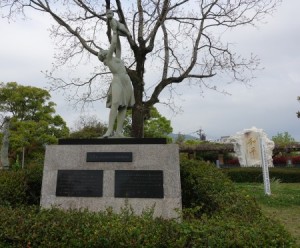
Statues were positioned throughout the garden. Some had signs in English while others were in other languages plus Japanese. The general theme revolved around women and children.
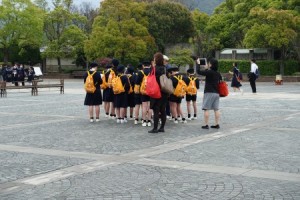
Groups of children dressed in uniforms were among the visitors. Today’s youth needs to be taught about the tragic events associated with wars.
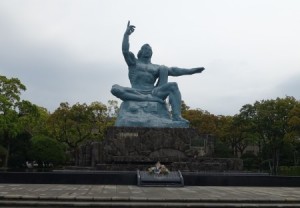
Small tour groups could be seen gathering in front of the famous Peace Statue.
The Peace Statue was designed by Seibo Ktamura and was built for the 10th anniversary of the bombing. This towering 10 meter bronze statue was made as an appeal for lasting world peace. The elevated right hand symbolizes the threat of nuclear weapons while the outstretched left hand illustrates world peace. The strong physique represent divine omnipotence. The closed eyes reflects a prayer for all war victims. The folded right leg shows quiet meditation while the left leg is ready to help others.
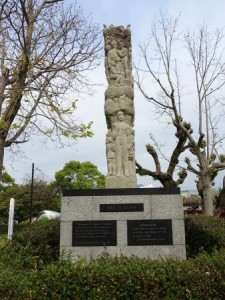
This statue is called the Monument of Peoples Friendship.
In 1981, The German Democratic Repulbic donated this piece of art to symbolize “the efforts for Peace and a happy future of Mankind for the Friendship among the Peoples.”
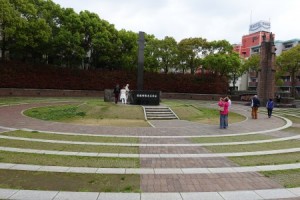
The above monument marks the epicenter. A nearby sign reiterates the full extent of the destruction with several statistics. More than 2.5 square miles of land were leveled. Tens of thousands of homes were either entirely burnt, reduced to rubble or partially destroyed. With an estimated population of 240,000 close to 74,000 perished and nearly 75,000 were injured.
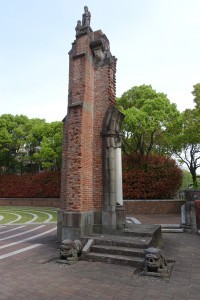
The Urakami Cathedral was completed in 1914. The Christian community took 30 years to build the church. At that time, the structure was recognized as being the largest Roman-style church in the East. It was originally located approximately 500 meters northeast of the atomic bomb hypocenter. This small portion of the wall was placed on this site in the late 1950 along with the newer stone statues on the column.
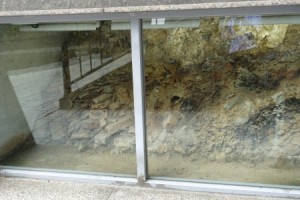
Signage near a staircase led us to pre-bomb ground level. Portions of the original ground level are preserved behind a display case.
We walked a short distance to the Nagasaki Atomic Bomb Museum. This modern structure includes exhibit that focus on August 9th, the damage caused by the bombing, the efforts being made to rid the world of nuclear weapons, and a video room.
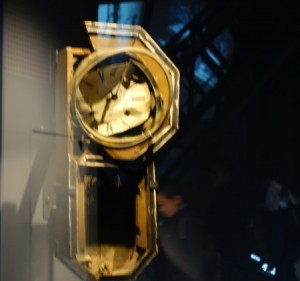
Near the entrance, the museum showcases a clock found at a home that was 800 meters from the hypocenter. The time was 11:02
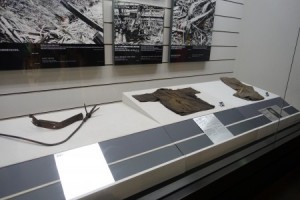
Artifacts provided a graphic display of the destruction.
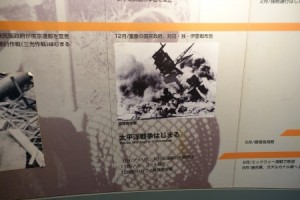
Timelines and videos provided facts.
On the timeline showing events for December 1942, the sign states:
Pacific War begins in December.
The Japanese attack on Pearl Harbor is not mentioned in the English part of this display. Occasionally when I visit a museum that is supposed to be warehouse of facts, I am disappointed by an incomplete assessment of a situation. I can only shake my head. Museum developers have an agenda that sometimes does not provide all of the facts. In this case, they conveniently left out why the Pacific War started and the cause of America’s involvement.
These three places provided a chilling reminder of the potent and devastating effects of nuclear weapons and the current efforts to bring about a peaceful world without nuclear weapons. Visiting Nagasaki’s main attractions provides an additional understanding to what happened to the people of Nagasaki and what they have done to curtail the development of nuclear weapons. If you find yourself in Nagasaki, it is a must see.
Related Posts
Churchill War Rooms- An Abundance of History
Precruise Exploration of Hong Kong
Fo Guang Shan Buddha Memorial Center
Old City of Akko- A City Beneath a City
Sandra’s Bio
Sandra Bornstein is the author of MAY THIS BE THE BEST YEAR OF YOUR LIFE. It is available on Amazon. Sandra’s memoir highlights her living and teaching adventure in Bangalore, India. She is a licensed Colorado teacher who has taught K-12 students in the United States and abroad as well as college level courses. Sandra is married and has four adult sons. The memoir was a finalist in the Travel category for the 2013 Next Generation Indie Book Awards, the 2013 International Book Awards, the 2013 National Indie Book Excellence Awards, the 2013 USA Best Book Awards, and received an Honorable Mention award in the Multicultural Non-Fiction category for the 2013 Global ebook Awards.
Leave a Reply
You must be logged in to post a comment.